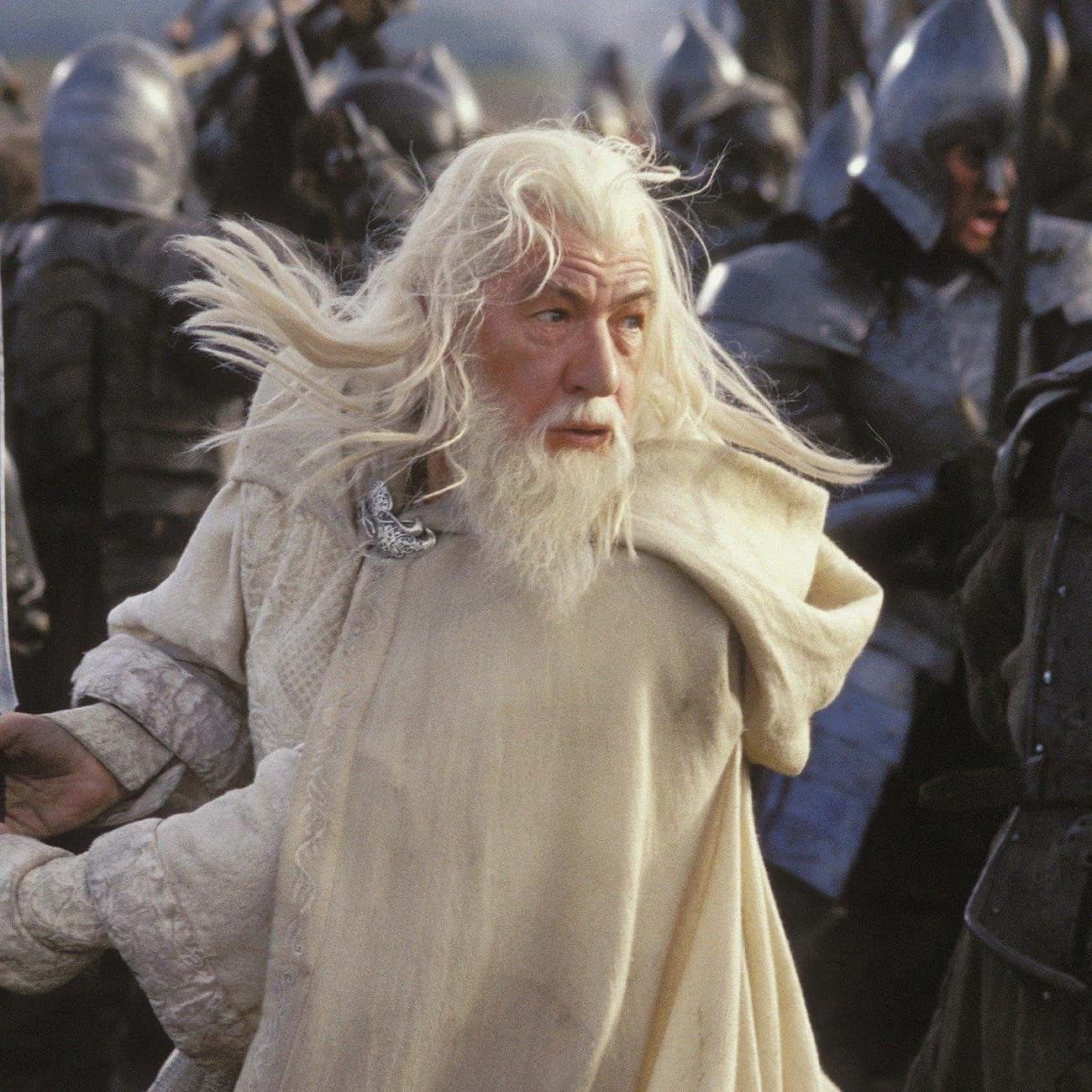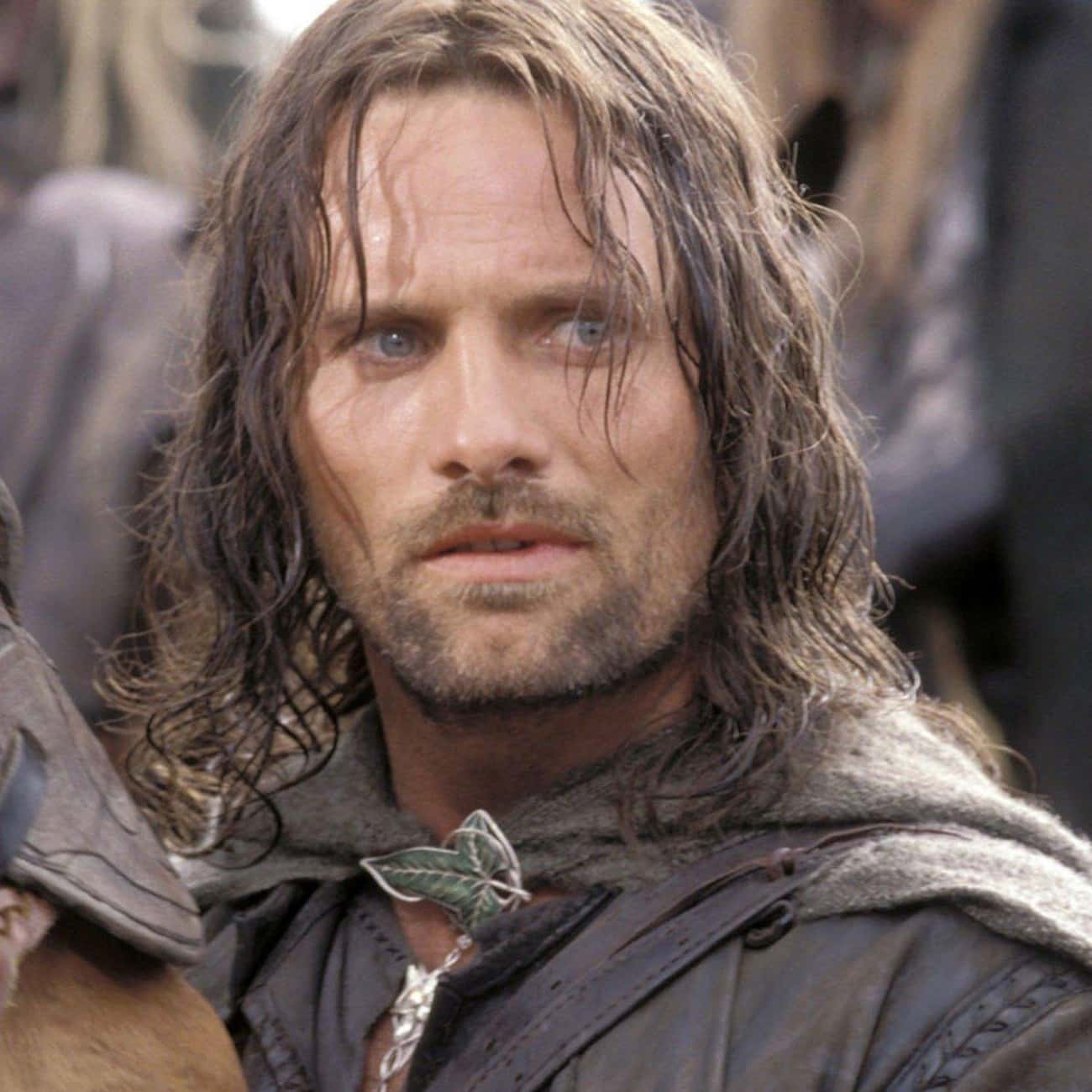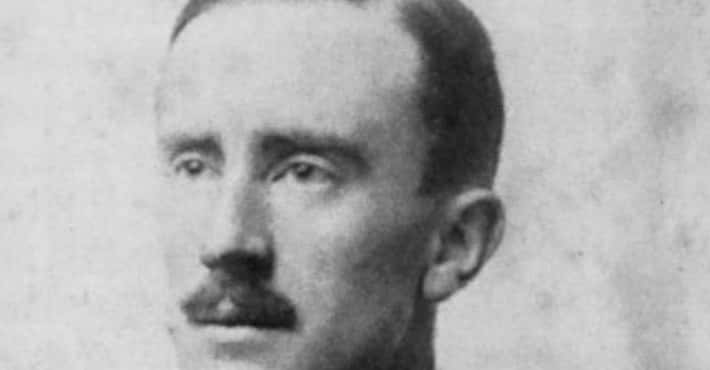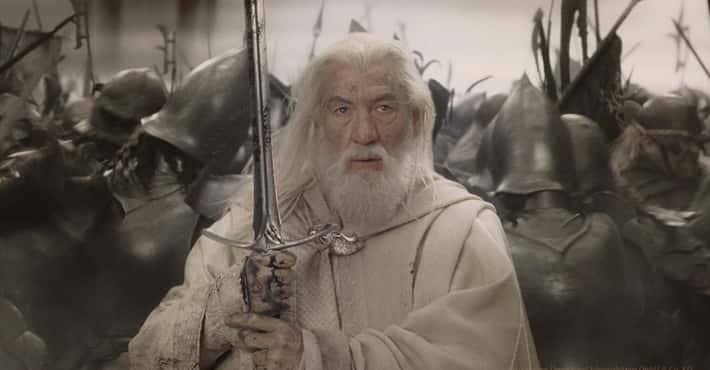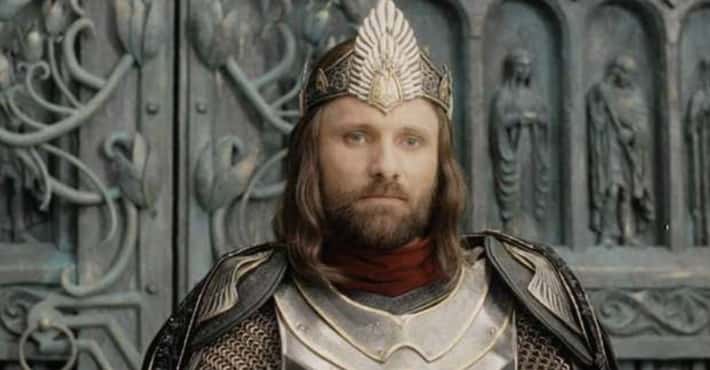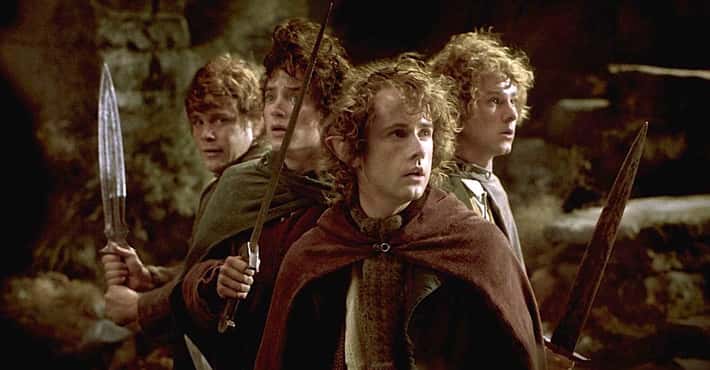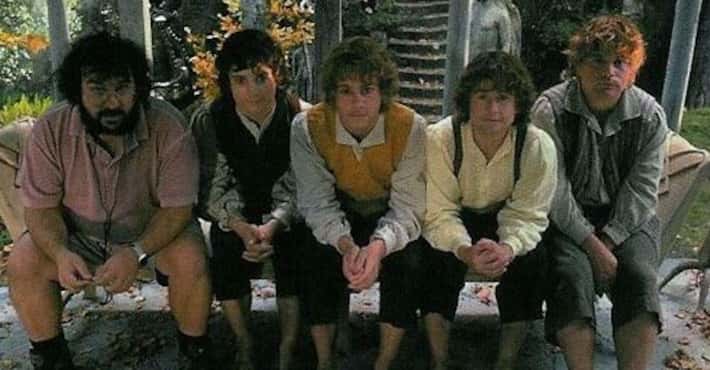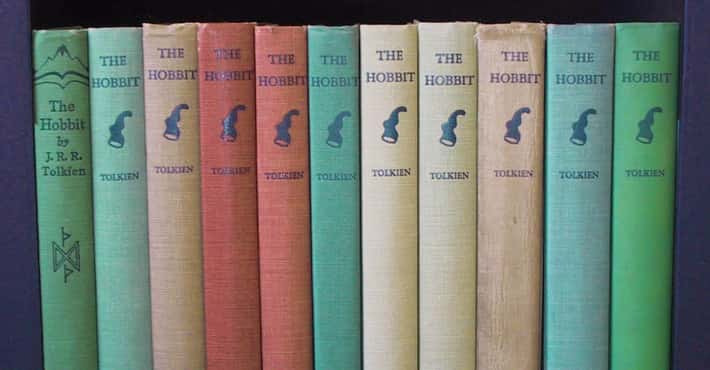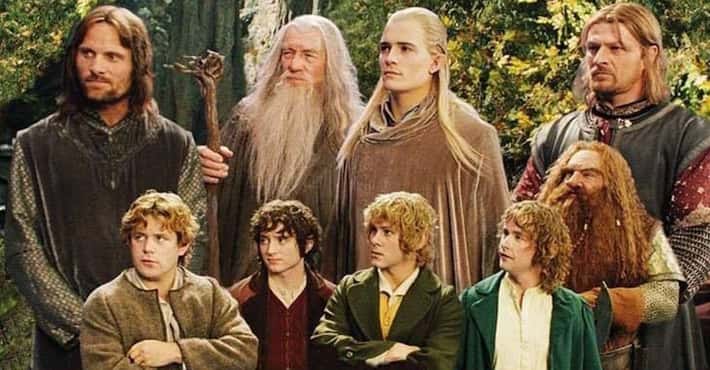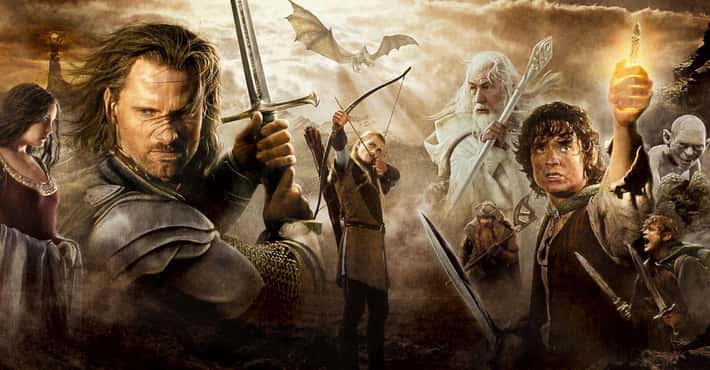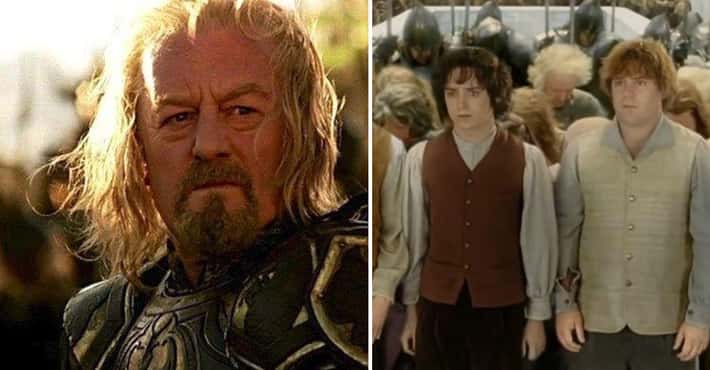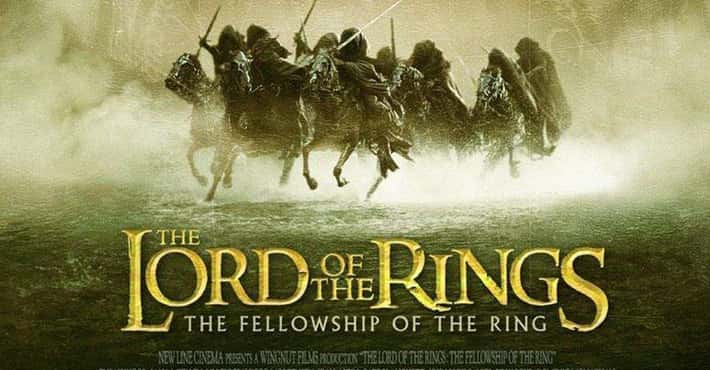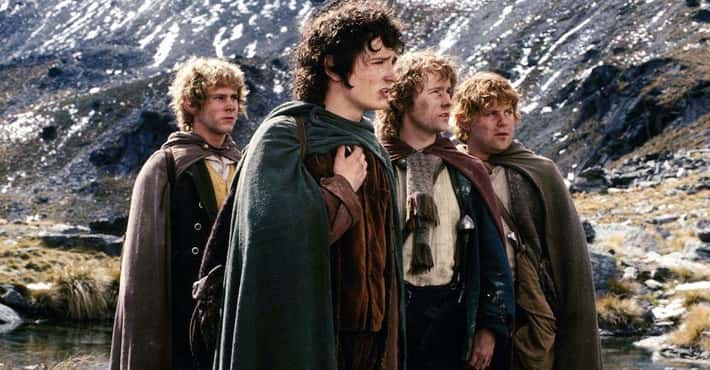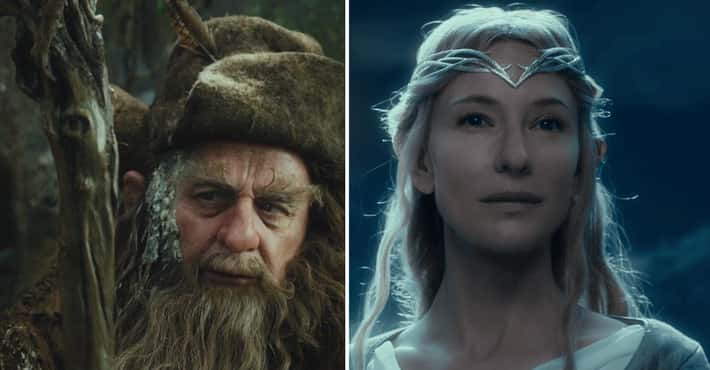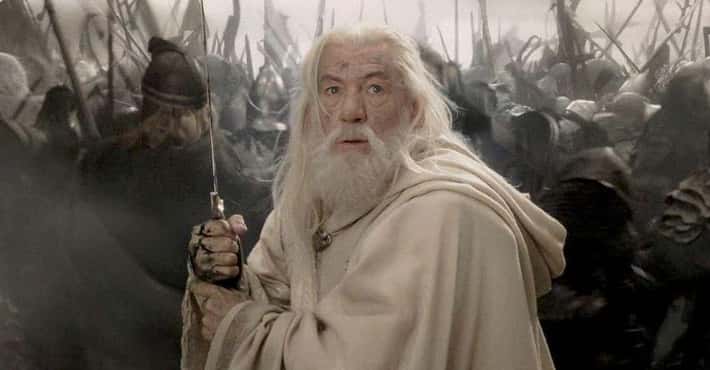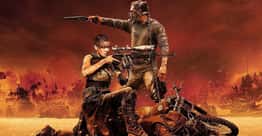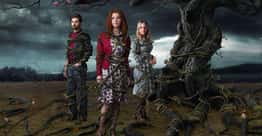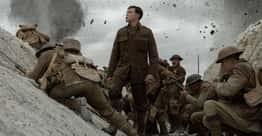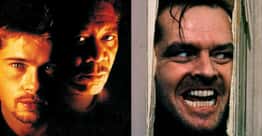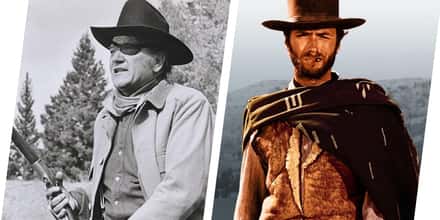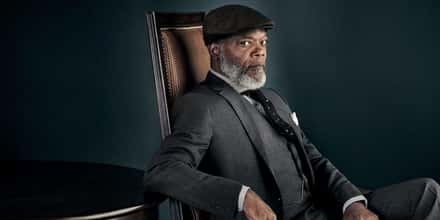Every 'Lord of the Rings' Movie, Ranked By How Much They Deserved Every Dollar
Vote up the Lord of the Rings movies that deserve the box office bank.
Through The Lord of the Rings, J.R.R. Tolkien created a unique, lived-in universe full of different species, battles, and One Ring to rule them all, which, in turn, became great films (and, maybe some not-so-great films.) The series has one of the biggest fandoms ever, and have won/been nominated for many Oscars.
But, the question is, did the movies deserve every dollar they earned at the box office? Did Ralph Bakshi's 1978 animated The Lord of The Rings get the box office praise it deserved? Or did Peter Jackson's The Hobbit: An Unexpected Journey get an undeserved boon? Grab your best friends for whom you would walk to Mordor and explore both the good and bad things about every Tolkien movie adaptation.
- Photo: New Line Cinema
What Did It Make At The Box Office? $1.156 billion
Premise: The Lord of the Rings: The Return of the King is the trilogy's final chapter, and it ends spectacularly. Frodo, Sam, and Gollum continue their trip to Mount Doom, but tensions rise between the two Hobbits as Gollum is waiting to betray them and take the One Ring for himself. The rest of the fellowship prepares for big battles with Sauron’s evil troops. After saving Minas Tirith from the forces of Mordo, Aragorn marches to the Black Gate to distract Sauron as Frodo arrives at Mount Doom. Unfortunately, he has succumbed to the Ring’s power and can't throw it away. Enter everyone’s favorite CGI creation, Gollum, who bites his finger and falls with the Ring into the lava, saving Middle-earth in the process. With Sauron destroyed and order restored, Aragorn becomes the titular returning king of Gondor, the Hobbits return to the Shire, while Bilbo, Frodo, and Gandalf sail west to the Undying Lands.
Strengths: Many believe this is the best movie in the trilogy, including The Academy. It won 11 Oscars, one of them being Best Picture (the first and only fantasy movie to get it,) and it still holds the record for most awards - tied with Titanic and Ben-Hur. The film has a perfect mix of action and heart, with Éowyn's great fight and killing of the Witch-King of Angmar, and Sam’s belief in Frodo even after they separate.
Best of all is the impressive Aragorn speech at Mordor's Black Gate that channels William Wallace in Braveheart, Captain America in Avengers: Endgame, and coach Tony D’Amato in Any Given Sunday levels of motivation for getting the troops fired up and ready for battle.
Weaknesses: So. Many. Endings. In a 201-minute movie, you can’t have so many almost endings, as people get frustrated and bored. Before that, the CGI looks worse than in the second film, especially in the Battle of Pelennor Fields. Saruman disappears, but rather than showing the audience, Gandalf tells us what happened to him, and that's it. No worries, he just was the bad guy from the two other movies. Even worse, The Army of the Dead is one big deus ex machina, and how they become allies of Aragorn is a very rushed subplot.
The biggest weakness of them all, though, might be that Tolkien’s son, Christopher, disavowed the film as he felt Jackson eviscerated the book by making it too action-focused and forgetting the novel's themes.
What Critics Said: The film was a slam dunk with most critics. Everyone felt it was a satisfying conclusion to the trilogy not only those who voted for the movie in the Academy Awards. Peter Bradshaw from The Guardian gave it four stars and said about it:
Hours after watching the film, I can close my eyes and see those incredible battle scenes pulsing and throbbing in my skull… His battles are a thing of wonder on their own account. Maybe Kurosawa's battles will one day be described as proto-Jacksonian. And for the first time in this series they are built on to a plot with some narrative force.
- Photo: New Line Cinema
What Did It Make At The Box Office? $884 million
Premise: Everything starts here, as we're introduced to Middle-earth, the original battle for the One Ring, Sauron, the fate of the world, and the Shire. One day, after a much-too-fun birthday party, the Hobbit Frodo Baggins inherits a ring. The Wizard Gandalf realizes that this is no ordinary ring, and eventually comes to the conclusion that it is the One Ring and that Frodo must journey to Rivendell to keep the ring safe. That brings its own problems as Frodo and his friends become the “Most Wanted” by every evil force in Middle-earth. After being stabbed by the Witch-King, they end up in Rivendell where a council decides that the One Ring must be destroyed. Frodo accepts the challenge and gets the help of his three Hobbit friends (Sam, Merry, and Pippin), an Elf (Legolas), two humans (Aragorn and Boromir), a Dwarf (Gimli), and Gandalf, creating the titular Fellowship of the Ring.
Strengths: Many said this was an unfilmable book, but Peter Jackson proved he was the man for the job, making a near-perfect adaptation. His world-building is impressive from the first exposition-heavy yet entertaining opening sequence, the incredible score by Howard Shore, and the idea of filming in New Zealand.
Even then, the biggest strength of this first chapter is the incredible cast and their chemistry together. There’s no way anyone other than Sir Ian McKellen could’ve been Gandalf, and the same happens with Elijah Wood as Frodo and the whole Fellowship of the Ring. A sequence in Rivendell shows all those qualities in one simple moment: “You have my sword, and you have my bow, and my axe.” If that moment doesn’t give you chills and make you want to become part of the Fellowship, this franchise is not for you.
Weaknesses: This movie is great, yet being the first in the trilogy, it has some weaknesses that are inherent to being chapter one. The film is a bit slow and is smaller in stature and stakes.
But its biggest weakness might be the fact that if you say that someone is going to betray the lead character and cast Sean Bean in the “I’m always dying” phase of his career, well, it’s not that much of a surprise when Boromir wants the Ring, is it? Even with Gandalf’s sacrifice and Boromir’s death, the movie still ends up a bit too open-ended, as it’s not enough of a cliffhanger for audiences dreading the year or waiting until the next film.
What Critics Said: Most critics loved the movie, both for its special effects and cast, lauding Jackson for creating a believable, real universe. Peter Travers at Rolling Stone said about it:
Fellowship is the real deal, a movie epic that pops your eyes out, piles on thrills and fun, and yet stays intimately attuned to character… Jackson is the wizard who gets it right.
- Photo: New Line Cinema
What Did It Make At The Box Office? $949 million
Premise: With the members of the Fellowship of the Ring divided, the whole world gets bigger. Frodo and Sam meet Gollum (who had the Ring for many years and looks at it as the one that got away,) Aragorn, Legolas, Gimli, and a resurrected Gandalf the White discover Saruman’s plan and help the people of Rohan move to the fortress of Hornbug at Helm’s Deep, and Merry and Pippin make new friends, the Ents. Gollum helps Sam and Frodo, being their guide into Mordor, before being caught by Rangers and taken away as Faramir, Boromir’s younger brother. Meanwhile, an incredible fight happens in Helm’s Deep. The forces of good are losing, and there's seems no hope left until Gandalf and Éomer arrive with reinforcements and turn the tides against the Uruk-hai. Meanwhile, Merry, Pippin, and the Ents storm the walls of Isengard.
Strengths: This film gets everything the first movie did and improves upon it, creating a much more epic tone. The world keeps getting bigger and bigger as audiences meet new characters and species of Middle-earth.
There’s the first full appearance of Andy Serkis as Gollum, an impressive CGI character that becomes the demon on Frodo’s shoulder to Sam’s Angel.
Even with all that, the two best things about this movie are the Battle at Helm’s Deep and Sam’s speech at the end. The battle at Helm’s Deep is one of the best combat sequences ever filmed. It has everything: drama, big stakes, chaos, action, tragedy, death, and even some comedy. Meanwhile, Sam’s speech is all about story, telling the thesis in Tolkien’s books and giving hope for what’s coming next.
Weaknesses: Most of The Lord of the Rings: The Two Towers weaknesses comes from its pacing as it's the middle chapter in the story. It feels incomplete.
The big fight at Helm’s Deep is incredible, but it takes a long time to get there. The characters evolve in weird ways, as Gimli not just becomes character-funny, but stand-up comic-in-his-Saturday-Night-Live-audition-funny, which is a bit too much and absolutely unnecessary. The other big problem in the story is Sam’s distrust of Gollum. He's right, but it becomes a bit one-note after a while, going from worried to almost jealous.
What Critics Said: This film got better reviews than the first one, and it made a perfect middle chapter. Keith Phillips at the AV Club said about the movie:
What makes Towers so staggering is the way it brings the full scope of Jackson's adaptation into focus. Without missing a beat in three hours, the film shifts from epic to lyrical and back.
- 426 VOTESPhoto: Warner Bros. Pictures
What Did It Make At The Box Office? $959 million
Premise: Gandalf leaves the team to investigate all the Necromancer. Meanwhile, the Dwarves and Bilbo keep getting in trouble with scary creatures, this time giant spiders. Legolas and Tauriel save the Dwarves from Mirkwood Forest but bring them to Thranduil who imprisons them for both trespassing and being Dwarves (there's still a lot of hate between Dwarfs and Elves). Bilbo saves them again with the power of the Ring, and the team escapes in barrels sent down river.
While Bilbo and the Dwarves reach the Lonely Mountain, their entry is barred by riddles. After Bilbo figures out how to get inside the lair of the dragon Smaug, he accidentally awakens the slumbering beast.
Strengths: The movie has some good things going for it. Having Legolas back is a treat, but even more is the introduction of Tauriel, an absolute kick-butt character.
Even then, the film’s MVP is Benedict Cumberbatch as Smaug. He goes all-in in his performance, having the time of his life as the CGI dragon, creating one of the best villains in Middle-earth. His best moment comes in his scene with Bilbo (a fun Sherlock reunion) where the chemistry between the two actors is proven as pure gold.
Weaknesses: The original idea for The Hobbit was to do two films, and here it shows why, as there's not enough material in the books for this middle film. The plot is stretched thin, with many unnecessary characters and story beats. There's no need for the Tauriel-Kili love story, especially since it's too similar to the Aragorn-Arwen one in the original trilogy. Gandalf’s investigation of the Necromancer (AKA Sauron), written solely for the movie to relate more to the Lord of the Rings trilogy, is also unnecessary.
Even if you don’t mind all these story setbacks, the biggest weakness of all might be the over-reliance on CGI and its quality.
What Critics Said: The film had mixed reviews, yet better ones than the first one in The Hobbit trilogy, as critics lauded the confidence and excitement of the movie. rogereberts.com' Sheila O’Malley gave it three and a half stars and said about it:
The thematic elements are in place, the emotional tension is highly strung, and the action unfolds in a wave like the fire erupting from the dragon's mouth, overtaking all in its path.
Unfortunately, other critics were less kind to the movie. The New Yorker’s Bruce Diones said about it:
The tale has no emotional resonance, and the thinness of the plot (only five of the book's chapters are adapted here) and the colorless depictions of the leading characters do it no favors.
- 523 VOTESPhoto: Warner Bros. Pictures
What Did It Make At The Box Office? $1.017 billion
Premise: Bilbo Baggins is just a normal, curious Hobbit who meets a wizard named Gandalf the Grey, hoping to recruit him to help him and his Dwarf friends get into the Lonely Mountain. Bilbo decides to go with them, and the unexpected journey begins. There are cameos from characters from The Lord of the Rings trilogy, like Arwen and Saruman the White (still a good, trustworthy guy) amid talk of a Necromancer. Bilbo and the Dwarves almost die a couple of times, and the Hobbit meets Gollum. They play a riddle game, and Bilbo finds a unique Ring and takes it.
Strengths: The movie has many great things going for it, starting with the casting of Martin Freeman as Bilbo Baggins, as he perfectly embodies the Hobbit's curious personality. The film's tone is breezier and more comedic than The Lord of the Rings, as proven by every Dwarf song, especially “The Misty Mountains,” which gets in your head and doesn’t leave you for days.
But, the best moment in the movie is the meeting between Bilbo and Gollum. Not only do they play some life-and-death riddles, but it has two moments that will be crucial for the original trilogy: Bilbo getting the One Ring and his choice to not kill Gollum.
The character arc between Bilbo and Thorin, where the Hobbit gains the Dwarf’s respect, is also pretty great.
Weaknesses: Let’s start with the most obvious weakness. One that keeps happening in the whole Hobbit trilogy: this movie and its two sequels are inferior to The Lord of the Rings trilogy.
It’s baffling that Peter Jackson also made these films. While he had to rescue them after Guillermo Del Toro couldn’t shoot them, there were still many choices that felt counter-intuitive to the those he made when shooting The Lord of the Rings like the over-reliance on CGI, and shooting the whole thing at 48 frames per second rather than 24, which made every moment a bit weirder and more jarring than it needed to be. As for the story, the pacing is odd, there are some ridiculous slap-sticky sequences where the lead characters should’ve died, and the ending with the eagles saving them is less than satisfactory.
What Critics Said: The film earned mixed reviews as it felt like a watered-down version of the first trilogy, yet still fun, and entertaining if a bit long. R. Kurt Osenlund at Slant Magazine lauded the film for its tone:
The tone of Jackson’s latest is, appropriately, much more jovial than that of Rings, which unfolds in an era far more stricken with despair.
Other critics, like San Francisco Chronicle’s Mick LaSalle, felt the original Hobbit book couldn’t hold three films, noting that:
This pressure, this obligation to stretch everything to the limits of endurance and beyond.
- 636 VOTESPhoto: NBC
What Did It Make At The Box Office? Nothing, as it aired on NBC.
Premise: This story is about adventure, as a simple Hobbit named Bilbo Baggins becomes one of the most important characters in Middle-earth's history. He’s part of a team with multiple Dwarves and a great Wizard named Gandalf, where they sing and fight against Trolls, Goblins, and giant spiders. Ultimately, they’re going to the Lonely Mountain, where a dragon named Smaug lives. It used to be the Dwarves’ home, but you can’t reason with a gold-obsessed dragon.
Bilbo meets a weird creature named Gollum and steals a magic Ring from him that will be important in the future. A human kills Smaug. Thorin gets gold crazy and almost starts a war against men and Elves until they all fight together in a big battle against Goblins. Bilbo gets knocked out at the start of it, so both he and the audience only see the consequences, including the many deaths of Dwarves. The Hobbit returns home a changed man (Hobbit), while still holding the powerful, dangerous Ring.
Strengths: This animated movie has many good things going for it as it’s a more faithful adaptation of The Hobbit book than the Peter Jackson films. It captures the spirit and tone of the novel, aiming it at children, and it’s only 78 minutes long. Its purist adaptation includes dialogue taken directly from the book and many of the songs on the page, transforming them into short, charming musical numbers. The voice cast is great, including famous director John Huston as Gandalf and Brother Theodore as a Gollum.
The biggest strength of them all might be its unique animation style. It was done in Japan by the same team that would later create the famous Studio Ghibli.
Weaknesses: The movie adapts the book faithfully, covering most of its story beats. Unfortunately, it does so in a bit of a too-simplified way, losing some of the essence of Tolkien’s characters, as there’s less adventure, wonder, and bravery. The compressed time also means less character development, leaving Thorin, the other big character in the book, less explored, and the rest of the Dwarves with no personality whatsoever. Telling everything that happens in the book without time for development also means that there’s no tension and every problem is easily resolved, usually by Gandalf, as he’s the powerful Wizard, making everyone else less resourceful and brave in the process, including Bilbo. The most jarring decision might be killing more Dwarves in the big battle than Tolkien or Jackson ever did. They don’t give them personality, yet they’re still the tragic fodder to show the consequences of war.
What Critics Said: The movie won a Peabody Award for its writing, and critics focused on the animation and how faithful it was to the book. Decent Films’ Steven D. Gredyanus gave it a C+ and said:
Arthur Rankin Jr. and Jules Bass bring their typically serviceable animation, strong voicework, and corny folk ballads to The Hobbit… worthwhile for kids and not too bad for parents.
- 730 VOTES
The Lord of the Rings (1978)
Photo: United ArtistsWhat Did It Make At The Box Office? $30.4 million
Premise: This movie crams the story of two books, The Fellowship of the Ring and The Two Towers, in one film. It all starts with a powerful Ring that gets lost to time until Hobbit Bilbo Baggins finds it. He then leaves it to his nephew Frodo, but Gandalf the Grey warns Frodo that dark forces are looking for it. The Hobbit and his friends start their adventure but are continuously in danger from everything and everyone. Even if it's a suicide mission, Frodo decides to take the Ring to Mordor to destroy it. Aragorn, Legolas, Gimli, Boromir, and his three Hobbit friends will help him do it. It looks like a solid plan until the teams get separated pretty soon afterward.
Frodo and Sam go to Mordor with Gollum, the worst guide ever. Meanwhile, Aragorn, Legolas, and Gimli go to the Helm’s Deep and unite with other humans against the Orcs sent by Saruman. After a long fight, the humans are just looking for an honorable death when Gandalf and the Riders of Rohan appear, winning the battle for the good side.
Strengths: This animated movie has its charms, starting with the performances (including Anthony Daniels of C-3PO fame as Legolas) in a film directed by animation genius Ralph Bakshi. As with any other Bakshi story, the film is adult-oriented and has a lot of graphic violence. It also has Tolkien’s written dialogue cadence, making it less accessible to kids. The best-written character is Frodo, who is much more similar to Tolkien’s version than the one performed by Elijah Wood in the live-action movies, which makes it more clear why he’s the one to get the Ring and make that incredible commitment and sacrifice.
Furthermore this is the film that influenced Peter Jackson to do his own version, and the director even shot the Hobbits hiding from the Black Rider similarly to Bakshi as an homage.
Weaknesses: Bakshi always loved experimentation in his animated movies, and here there’s a lot of it, too much really, mixing animated styles that don’t complement each other. He goes from traditional 2D animation into rotoscope animation (tracing photographs of real-life actors).
Even then, the biggest weakness is that this film tried to adapt two books in a two-hour movie, leaving out too many iconic scenes and characters like Faramir and Arwen. It goes through the plot as quickly as you can say: “You shall not pass!” This movie ends on a cliffhanger, as Bakshi had plans for a sequel. Unfortunately, the studio never green-lighted it as the movie got a lot of hatred from Tolkien fans.
What Critics Said: The reviews were not great, with many critics acknowledging how complicated it was to tell this enormous story in just two hours. Famous critic Roger Ebert gave the movie two and a half stars, and said it best:
Bakshi has done an entirely respectable, occasionally impressive job of transferring to the screen Tolkien's detailed thousand-page epic fable of Middle-earth. The bad news is that, good script, $8-million budget, and slam-bang animation aside, it still falls far short of the charm and sweep of the original story.
- 818 VOTESPhoto: ABC
What Did It Make At The Box Office? Nothing, as it aired on ABC.
Premise: This finishes telling the story Frodo's quest to destroy the One Ring. Samwise starts out on a rescue mission to free Frodo from the Orc fortress of Cirith Ungol, while Gandalf travels with Merry to Gondor to warn them of the upcoming clash. Samwise and Frodo make their way across Mordor to Mount Doom, but Frodo fully succumbs to the Ring after Samwise fights off Gollum. Sam ultimately spares the former Ring-bearer's life, but he is unable to break Frodo from the Ring's control. Ultimately, Gollum bites off Frodo's finger in a fight, takes the Ring, and falls into the lava of Mount Doom to unintentionally complete the quest.
At the same time, Gandalf musters the forces of Gondor in the Battle of Pelennor Fields. Theodon leads the riders of Rohan into battle, but falls to the Witch-King of Angmar. His niece Éowyn avenges him, but the tide of the battle almost turns against the forces of mankind before Aragorn arrives with reinforcements and immediately ends the battle. Aragorn leads the unified forces to the gates of Cirith Ungol, arriving to confront the Mouth of Sauron conveniently at the same time Gollum falls into Mount Doom with the Ring.
The eagles rescue Frodo and Sam from Mount Doom just in time, Aragorn becomes king of Gondor, and after a flash-forward to years later, Frodo gifts a copy of his and his uncle Bilbo's memoirs to Sam before traveling to the Grey Havens with Gandalf and Elrond.
Strengths: For all its notorious flaws, there is no shortage of style or vibes in this take on the story. The animation team from Rankin Bass builds on the work from their adaptation of The Hobbit. It also starts at the same point as the book, with Frodo held hostage by Orcs. There are also a number of songs and unexpected musical cues that have built up a “so bad, it's good” reputation for their meme-able potential. The voice cast carries over from The Hobbit, as well as radio DJ Casey Kasem as Merry.
Weaknesses: The movie has a lot of issues, but the biggest is how it condenses the plot to get through the epic story in the tight, 97-minute runtime of a TV movie. It jumps from scene to scene quickly and abruptly, leaving a lot of questions about what is going on for viewers not already familiar with the books. There isn't much effort put into establishing a strong timeline either, with Aragron's arrival to end the Battle of Pelennor Fields and days long march to Mordor crosscut with the seemingly 30-minute stretch of time Frodo, Sam, and Gollumn spend at the top of Mount Doom. It also disappoints the truest Tolkien fans with lines that mispronounce key terms like Minas Tirith, Cirith Ungol, Gorgoroth, and Barad-dûr.
What Critics Said: The movie averages a decent 67% critics score on Rotten Tomatoes, but a rotten 39% average from audiences. Decent Films’ Steven D. Gredyanus gave it a C and said it provides “little to interest even the most avid adult Tolkien and/or animation buff” due to its clear attempts at appealing to younger audiences.
- Photo: Warner Bros. Pictures
What Did It Make At The Box Office? $962.3 million
Premise: The second film ends with the cliffhanger of Smaug being let out of the mountain and going to destroy Lake-town, so, this movie starts with the dragon’s battle with Bard, who has the last black arrow that can kill him, and does so.
Thorin now gets all the gold inside the mountain and becomes too greedy about it, as he tries to keep all of it for himself, consequences be damned. Galadriel, Elrond, and Saruman save Gandalf from a formless Sauron and discover an Orc army is on its way to Ravenhill. Elves, men, Dwarves, and Eagles fight against the Orcs in the combat that gives the film its title. Thorin, Fili, and Kili die, but good wins against evil. Bilbo goes back to the Shire with stories of adventures to tell, and with the Ring in his hands even though he tells Gandalf that he lost it.
Strengths: This film has some great moments, especially its battles that use more than half of the 144 minutes runtime. Not only in the titular battle of the five armies, but also during the destruction of Lake-town, which started the film with a bang after audiences had been left waiting on a cliffhanger. Jackson and his team learned a lot about how to shoot and edit the battles in the first trilogy, and it shows.
What anchors the movie, however, is Bilbo. During the last conversation between him and Thorin it becomes clear they’ve learned to respect each other and have become friends. Furthermore, in Bilbo’s last scene when he returns home as a changed person perfectly describes a feeling everyone has had after important life experiences.
Weaknesses: As with every movie in The Hobbit trilogy, the pace of the story and the CGI are jarring problems that don’t go away. Thorin’s arc feels sudden as his dragon fever and greed come out of nowhere, even for a Dwarf who loves gold. The character should’ve been as great as Aragorn, yet, even with Richard Armitage’s commitment, it quite never lands there, resulting in character's death that isn’t as tragic, soul-crushing, or deserved as it should be.
The whole final battle is good, but it's surprisingly long, a full hour, when in the book, Bilbo is knocked out at the start of it. Finally, having Legolas going to find a Ranger that goes by Strider (AKA Aragorn) is absolutely unnecessary, and even more so when you think this movie is happening 77 years before the original trilogy, making Aragorn ten years old when this story is developing.
What Critics Said: It’s a bit sad that Peter Jackson’s relationship with Middle-earth ended with this movie, as it had mixed reviews, and more critics disliked it than loved it,. The best thing they could say was that it was reasonably satisfying, even if there was no need for it being three movies. San Diego Reader’s Matthew Lickona puts it best when he said:
Look, if you were as bloated as The Hobbit trilogy, you'd probably be showing signs of exhaustion toward the end of a nearly nine-hour runtime, too.
Grantland’s Wesley Morris liked it more than Lickona, even if he believed this movie should’ve come sooner, saying about it:
This new movie is like some cupcake frosting or the orgasmic finale of a fireworks show: It operates under the assumption that too much is what we want. Put it this way: Too much is better than nothing. But too much would have come in handy five and a half hours and two years ago.


